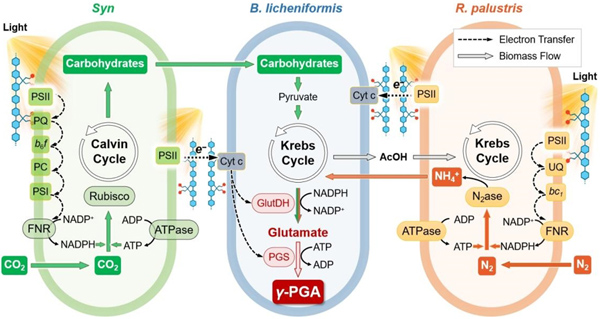Researchers Develop Solar-Powered Multi-Organism Symbiont Mimic System for Beyond Natural Synthesis of Polypeptides from CO2 and N2
Carbon neutrality is widely recognized as a crucial tool for addressing climate action and promoting sustainable development, given the dramatically increase in CO2 levels caused by the fossil fuels utilization and human activities. However, the sustainable conversion of CO2 into high value-added longer chain products has important technical and social implications. Moreover, nitrogen immobilization plays a crucial role in the biogeochemical cycle, with significant impacts on the agricultural and food industries. The symbiotic nitrogen fixation with microorganisms in plants is the most extensive natural source of bioavailable nitrogen source in the biosphere. Biological symbiosis system is also an effective way for carbon sequestration, as it supports complementary metabolism and facilitates the conversion of CO2 through intimate electronic and substance communications. Unfortunately, the low efficiency of electronic and substance communications between species results in an unsatisfying low atom economy. Thus, developing artificial symbionts that mimic how symbiotic algae and microorganisms fix CO2 and nitrogen to produce proteins or polypeptides beyond natural synthesis limitations could revolutionize the fields of agriculture, medicine, environment and food. Conductive polymers offer several advantages, including the adjustable band gap, good biocompatibility and good conductivity. It has been verified that combining conductive polymers with cyanobacteria can improve the photosynthesis, promote the biomass conversion, and enhance photoelectric efficiency by regulating the biological process directly and indirectly. As a result, they represent an exciting opportunity for developing artificial symbionts on demand.
A research team, led by Prof. WANG Shu and Prof. BAI Haotian from the Institute of Chemistry, Chinese Academy of Sciences (ICCAS), recently proposed a new strategy of biosynthesis by constructing a solar-driven biosynthetic circuit. This circuit is capable of programmable synthesis of functional polypeptides from CO2 and N2 in multi-organism assemblies based on direct interspecific substance and electron transfer (DISET). The modular design was adopted to couple the CO2 fixation module of Synechocystis sp., N2 fixation module of Rhodopseudomonas palustris, γ-polyglutamic acid (γ-PGA) synthesis module of Bacillus licheniformis and the electron transfer module of conductive polymer (PFP: cationic poly (fluorene-co-phenylene) derivative). The PFP, with excellent light capture ability, could argument photosynthesis of Syn and R. palustris, thus improving the fixation of CO2 and N2. B. licheniformis can transform carbohydrate and NH4+ into γ-PGA biopolymer through bacterial metabolic pathway. Attributing to the conductivity conjugated polymers, the positively charged PFP could make the three organisms gather and form a conductive network, resulting the promoted direct interspecific electron transfer, enhanced intracellular ATP and NADPH and the final γ-PGA synthesis. The logic biosynthesis circuit is then employed to the production of other polypeptide of antibiotic bacitracin A.
In the future, the light capturing ability optimization of materials and directional assembly of material-microbial interface are expected to achieve specific product formation and possibly achieve higher production efficiency by adjusting microbial metabolic network in artificial symbiont. The advantages of artificial symbiont integrated material/microorganism hybrid, high solar capture, efficient charge transfer, and selective biosynthesis would probably break through the limit of light-driven biosynthesis. This artificial symbiont provided a new tool for the programmable biosynthesis of functional peptides and proteins, prospecting broad applications on the frontier of medicine, food, energy, and environmental protection. Compared with the current challenging conditions for fixing CO2 and N2 fixation, it is of greater practical significance to convert airborne CO2 and N2 into high-value products under normal temperature and pressure by constructing solar-powered multi-organism symbiont.
The study was published in Science Advances(2023, DOI: 10.1126/sciadv.adf6772) .

Schematic diagram of solar-powered multi-organism symbiont mimic system for beyond natural synthesis of polypeptides from CO2 and N2. (Image by YU Wen)
Contact:
Prof. WANG Shu
Prof. BAI Haotian
Institute of Chemistry, Chinese Academy of Sciences
Email: wangshu@iccas.ac.cn; baihaotian@iccas.ac.cn





